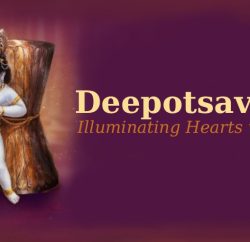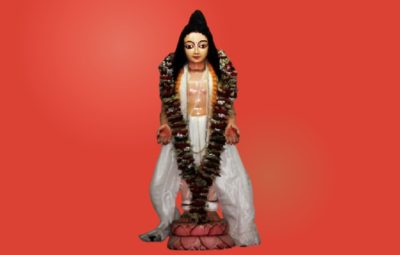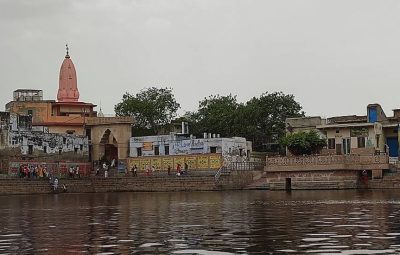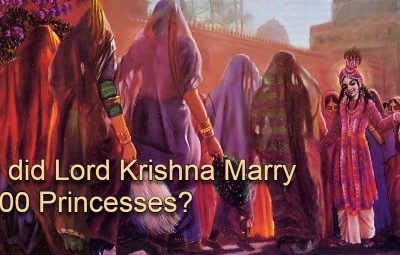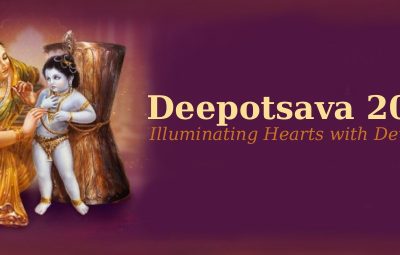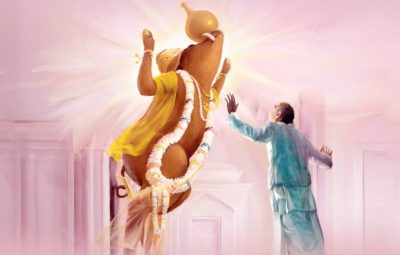On the order of Sri Chaitanya Mahaprabhu, Sri Nityananda Prabhu travelled to Bengal for preaching and accepted the grihastha ashram (householder life). Sri Chaitanya Mahaprabhu blessed Nityananda Prabhu, saying that He would soon appear in his family. Sri Nityananda Prabhu married Suryadas’s daughters, Sri Jahnava and Sri Vasudha, and settled in Khardaha.
The Abhirama Lilamrita describes a pastime of Abhirama Thakura’s arrival in Khardaha. Abhirama Thakura was one of the prominent twelve cowherd boys and possessed a very powerful spiritual personality. Whenever he offered obeisances to any person who was not the Lord Himself or empowered by the Lord, that person would die immediately. Similarly, if he bowed down to a stone that was not a Salagrama Sila, that stone would crack immediately. All the previous sons of Sri Nityananda Prabhu had died because Srila Abhirama Thakura had offered them obeisances.
Sri Virabhadra Prabhu was born to Sri Nityananda Prabhu and Sri Vasudha on the ninth day of the dark fortnight in the month of Kartika. When Srila Abhirama Thakura paid his obeisances to Sri Virabhadra Prabhu, no harm came to the child. Srila Abhirama Thakura became overjoyed and composed verses glorifying him.
Srila Krishnadasa Kaviraja glorifies Sri Virabhadra Prabhu in Sri Chaitanya Charitamrita as follows:
“After Nityananda Prabhu, the greatest branch is Virabhadra Goswami, who also has innumerable branches and sub-branches. It is not possible to describe them all. Although Virabhadra Goswami was the Supreme Personality of Godhead, He presented Himself as a great devotee. And although the Supreme Godhead is transcendental to all Vedic injunctions, He strictly followed the Vedic rituals. He is the main pillar in the hall of devotional service erected by Sri Chaitanya Mahaprabhu. He knew within Himself that He was the Supreme Lord Vishnu, but externally He remained prideless. It is by the glorious mercy of Sri Virabhadra Goswami that people all over the world now have the chance to chant the names of Chaitanya and Nityananda. I therefore take shelter of the lotus feet of Virabhadra Goswami, so that by His mercy my great desire to write Sri Chaitanya-caritamrta will be properly guided.”
Sri Virabhadra Prabhu was a disciple of his stepmother, Sri Jahnava Mata. The Bhakti-ratnakara mentions that in a village named Jhamatpura (Hugli district), Sri Virabhadra Prabhu had a disciple named Sri Yadunatha Acharya. He had two daughters—a biological daughter named Srimati and a foster daughter named Narayani. Both these daughters were married to Sri Virabhadra Prabhu.
After receiving permission from his mother, Sri Virabhadra Prabhu undertook a sacred pilgrimage to Sri Vrindavana Dham. His journey began with a visit to the home of Uddharana Datta Thakura in Saptagrama, where he was warmly received by Uddharana Datta Thakura’s son, Srinivasa Datta Thakura. Sri Virabhadra Prabhu remained there for two days before proceeding to Shantipura to visit the residence of Sri Advaita Acharya. There, Advaita Acharya’s son, Sri Krishna Mishra, extended a cordial welcome with a full reception, and joyous sankirtan filled the atmosphere, immersing everyone in the sweet waves of the holy name.
From Shantipura, Sri Virabhadra Prabhu travelled to Ambika Kalna to visit the home of Sri Gauridasa Pandit, where Sri Hridaya Chaitanya Prabhu greeted him with great warmth and affection. His next destination was Navadwipa Dham, to the house of Sri Jagannatha Mishra. Upon seeing the son of Nityananda Prabhu, all the followers of Sri Chaitanya Mahaprabhu present there were filled with joy and welcomed him with great happiness. After spending two days there, he journeyed to Sri Khanda, where Sri Raghunandana and Sri Kanai Thakura received him affectionately with warm embraces.
Following his stay in Sri Khanda, he continued to Jajigrama to visit the residence of Srinivasa Acharya. With profound devotion, Srinivasa Acharya offered worship to Sri Virabhadra Prabhu, recognising him as the Supreme Personality of Godhead. He stayed there for several days, during which a magnificent sankirtan festival took place. Sri Virabhadra Prabhu then proceeded to Kanthak Nagara, near Katwa, the sacred place where Mahaprabhu accepted sannyasa. After staying for a day, he travelled to Badhurigram and arrived at the home of Govinda Kaviraja. The advanced Vaisnava, Govinda Kaviraja, received him with great devotion and worshipped him with elaborate puja. Deeply pleased by his exceptional devotion, Sri Virabhadra Prabhu remained at his residence for two days.
Subsequently, he visited Kheturi Gram, the birthplace of Srila Narottama Dasa Thakura. The Bhakti Ratnakara records: “To infinitely increase Sri Narottama Dasa Thakura’s bliss, that prominent branch of the Sri Chaitanya tree, Sri Virabhadra Prabhu, came to Kheturi Gram and danced in sankirtan. At that time, countless people gathered to see Sri Virabhadra Prabhu, who is Vishnu Himself.”
After spending several days in Kheturi Gram celebrating with grand sankirtan festivals, Sri Virabhadra Prabhu continued his journey toward Vrindavana. Through his divine influence, many sinners and atheists were delivered along the way. When news of his auspicious arrival reached Vrindavana, the prominent devotees there assembled on the road to welcome him. These great souls included Sri Jiva Goswami, Srimad Krishnadasa Kaviraja Goswami, Sri Ananta Acharya and Sri Haridasa Pandita (who were disciples of Sri Gadadhara Pandit and served as pujaris of the Sri Madana-Mohana Deity), Sri Krishnadasa Brahmachari, Sri Gopinatha Adhikari, Sri Madhu Pandita, Bhavananda (the pujari of Sri Gopinatha), Kashishvara and his disciples Sri Govinda Goswami (the pujari of Sri Govinda in Vrindavana) and Sri Yadava Acharya, along with many others.
The Bhakti Ratnakara states, “Everyone came forth to see Sri Virabhadra Prabhu, and all the residents of Vrindavana were delighted to receive his darshan. There was not a single person who remained untouched by witnessing the extraordinary ecstatic bhakti displayed by Sri Virabhadra Prabhu. He sang glorifying the superlative qualities of Vrindavana and all the Vaishnavas residing there. Following this, he visited the Deities of Sri Govinda, Sri Gopinatha, and Sri Madana Mohana and took darshan of their sacred forms.”
Subsequently, under the guidance of Sri Jiva Goswami and Sri Bhugarbha Goswami, Sri Virabhadra Prabhu embarked on an extensive pilgrimage throughout the forests of Vrindavan. He visited the twelve forests of Vrindavan, Radha Kunda, Shyama Kunda, and Govardhana Hill. As he beheld these sacred sites, he manifested astonishing and wonderful expressions of divine love. All the residents of Vrindavana were captivated by these demonstrations of ecstasy in Krishna-bhakti. In this manner, after gradually visiting all the significant holy places in Vrindavana, Sri Virabhadra Prabhu returned to Gaudadesha. Those who were fortunate enough to witness his ecstatic love praised his glories far and wide.
The Prema Vilasa states that Sri Virabhadra Prabhu, having received specific instructions from his father Nityananda Prabhu to install Sri Shyamasundara ji in Khardaha, embarked on a journey to obtain a salagrama sila from the Nawab’s palace in Murshidabad. This sacred stone was needed to carve the Deity.
Sri Virabhadra Prabhu’s renowned reputation had reached the Nawab beforehand, and upon his arrival, the Nawab received him with full honours. However, beneath this respectful facade, the Nawab harboured malicious intentions. He devised a sinister plot to defile Sri Virabhadra’s sacred vows by serving him meat. The Nawab calculated that by feeding non-vegetarian food to this great Vaisnava, he would cause him to fall from his religious path and thereby destroy his reputation.
However, when the Nawab attempted to serve the non-vegetarian dishes, a miraculous transformation occurred—the food automatically turned into roses and jasmine flowers. The Nawab commanded his chef to prepare fresh items, but repeatedly, through Sri Virabhadra’s spiritual potency, the food continued transforming into flowers. Growing increasingly frustrated with his failed attempts, the Nawab finally realised that Sri Virabhadra Prabhu was no ordinary person but a great devotee of immense spiritual power.
Overcome with remorse and guilt, the Nawab fell at Sri Virabhadra’s lotus feet and begged for forgiveness. Moved by compassion, Sri Virabhadra Prabhu pardoned him. Sri Virabhadra then mentioned to the Nawab, “I noticed a massive stone above your front gate. I would be pleased to have it so I can carve a beautiful Deity from it.” The Nawab gladly gave his consent.
Sri Virabhadra Prabhu then transported the stone back to Khardaha in an extraordinary manner—by floating it down the Ganges River, as it was far too heavy to be placed on a boat. To everyone’s astonishment, the salagrama stone floated downstream and eventually reached the banks of Khardaha, where it was carefully retrieved.
This particular salagrama sila had a significant history. It was the very same stone upon which Kamsa, the wicked maternal uncle of Sri Krishna, had murdered Devaki’s six children over 5,000 years ago. Through the course of time, this stone had somehow come into the Nawab’s possession.
Sri Virabhadra then engaged a skilled sculptor who undertook the sacred task of carving the enchanting Deity of Lord Shyamasundara from this salagrama sila. The first two Deities that were sculpted did not precisely match the divine form of Sri Shyamasundara ji that Sri Virabhadra had witnessed during his meditation. Therefore, he sent these first two Deities to Serampore and Saibon, where they are worshipped to this day as Sri Radhavallabha ji and Sri Radha Nandadulala ji, respectively.
The third Deity carved from the salagrama sila was an exact match to his divine vision, and Sri Virabhadra then proceeded to install and worship it with great devotion. Indeed, the people of Khardaha forgot all their distress upon beholding this most captivating Deity.
Sri Virabhadra Prabhu organised a magnificent festival to install the Deity with great splendour and ceremony. He invited numerous devotees and fed them all lavishly. The most merciful Acyutananda, the son of Advaita Acharya, performed the sacred abhiseka (bathing ceremony) of Sri Radha Shyamasundara ji.
Gopijana Vallabha, Ramakrishna, and Ramachandra were believed to be sons of Sri Virabhadra Prabhu. The youngest, Ramachandra, belonged to the Sandilya dynasty and had the surname Varavyala. He established his family at Khardaha, and its members are known as the Goswamis of Khardaha. His eldest disciple, Gopijana-vallabha, was a resident of a village known as Lata near the Manakara railway station in the district of Burdwan. The second, Ramakrishna, lived near Malda in a village named Gayeshpura. Srila Bhaktisiddhanta Saraswati Thakura remarks in his Anubhashya that since all three belong to different gotras (dynasties), and also had different surnames and lived in different places, it is not possible to accept them as biological sons of Sri Virabhadra Goswami.
Srila Kavi Karnapura has written (Sri Gaura-ganodesa-dipika, text 67):
sankarsanasya yo vyuhah payo-visayi-namakah
sa eva viracandro ‘bhuc caitanyabhinna-vigrahah
“The expansion of Lord Sankarshana known as Kshirodakasayi Vishnu, appeared in Sri Chaitanya Mahaprabhu’s pastimes as Virachandra Prabhu. Lord Virachandra was non-different from Lord Chaitanya Himself.”




